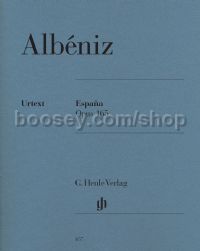España, Op.165 (Piano)
España, Op.165 (Piano)
* Estimated price converted from UK retail price
When the Catalan composer Albéniz wrote his six album leaves “España” at the age of 30, he was in London and his piano recitals were causing a sensation. At these concerts he often performed his own compositions which were infused with the flair of his home country. Albéniz also gave the first performance of the piano cycle “España” in London, taking his audience on a journey through the Spanish countryside: exotic dance rhythms (“Zortzico”) and melodic folk tunes (“Serenata”) are preceded by the famous “Tango”, made known through many arrangements.
Preface
“Señor Albéniz may well inscribe upon his escutcheon the words ‘Veni, vidi, vici’.” With these words, Vanity Fair commented, in its issue of 29 November 1890, upon the overwhelming victory that Isaac Albéniz had won as a pianist in highly-acclaimed concerts since his arrival in Britain in summer 1889. This great English success led him to abandon his home country of Spain for a long period, and to take up residence in London between 1890 and 1893.
In the preceding years, Albéniz had already made a name as a pianist outside England. His substantial solo programs usually presented a cross-section of brilliant piano repertoire, ranging from the Baroque to the contemporary. Writing about a concert that Albeniz had given on 7 June 1890 in London’s Steinway Hall, The Times reported on 10 June that: “The […] artist treated his audience to no fewer than 25 complete compositions.” These included a set of variations by George Frideric Handel, two sonatas by Domenico Scarlatti, and the Sonata in bb minor op. 35 of
Frédéric Chopin, along with paraphrases on operas by Richard Wagner. This concert was also the occasion on which Albéniz first publicly performed his España – “six graceful ‘album leaves’,” according to the Times. It had become his custom to include his own compositions on Spanish subjects within his concert programs: their exotic flair apparently touched a nerve with audiences of the time. These pieces, just like the Chants d’Espagne op. 232, also composed in London, have remained among his most popular works up to the present day.
The circumstances surrounding composition of the pieces from España are unknown. The cycle was published that same year, 1890, by the London publisher Pitt & Hatzfeld with the same subtitle (Six Album Leaves) already used in the review in the Times. No manuscript sources survive. The copyright statement for the first edition lists H. B. Stevens & C.o, a Boston publisher whose name also appears on the title page of the print, probably in order to secure the rights for the American market. In 1893, the British firm of Pitt & Hatzfeld amalgamated with Stanley Lucas, Weber & Co. The re-separation of the two business partners in 1899 led to several auctions of copyrights. Schott London took the opportunity to acquire the rights to España, and during Albeniz's lifetime published several versions of the print using the plates of the first edition. It cannot be determined whether interventions in the musical text (principally in the Tango; see the Comments) derive from the composer. It is also unclear what the significance is of the note Edited by L. H. Meyer that appears on the first edition from Pitt & Hatzfeld and on all later issues. Perhaps this Meyer, no longer remembered today, was a middle-man or publisher’s editor who prepared España for engraving.
The work’s dedicatee, Arthur Chappell, was an important figure in London’s concert life. He organised the “Popular Concerts” in St. James’ Hall, where Albéniz appeared in his first recitals in England in 1889. The composer often used St. James’ Hall as a venue for his concert series in the years that followed. It may be assumed that Albeniz worked closely with Chappell on these occasions.
Of the six pieces (Prélude, Tango, Malagueña, Serenata, Capricho Catalán, Zortzico) it is the Tango that has gained the most popularity, and has been arranged – though not by the composer himself – for various forces. The Zortzico, a folk-dance in quintuple meter with a characteristic dotted rhythm, belongs among the very few of Albeniz's works that make reference to his Basque origins. Taken together, all six album leaves reveal – by Albéniz’s standards – an extremely transparent and easy-toplay piano texture, suggesting that the composer may have written this cycle with pedagogical intent.
Those libraries named in the Comments at the end of this edition are warmly thanked for making copies of the sources available. Special thanks are due to Walter Aaron Clark, who answered the editor’s questions concerning Albeniz's time in London.
Munich, autumn 2009
Norbert Müllemann




